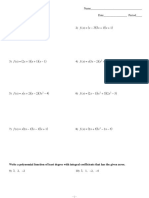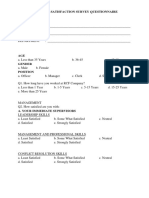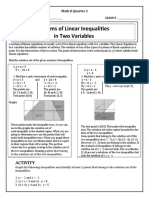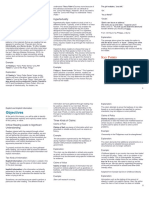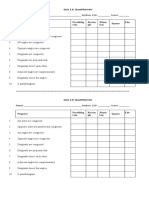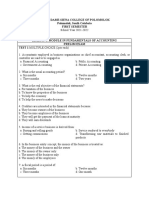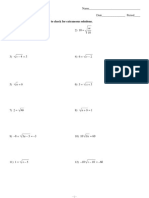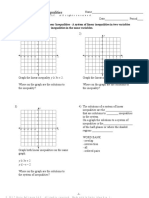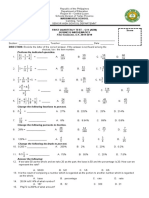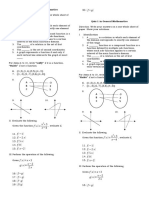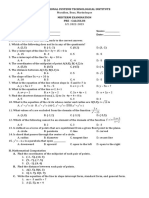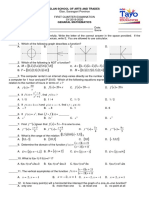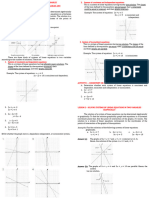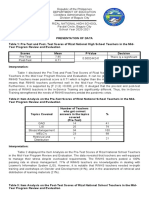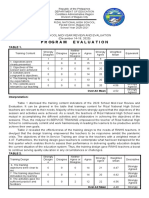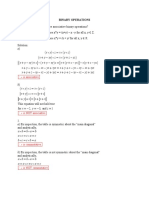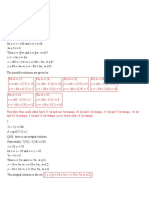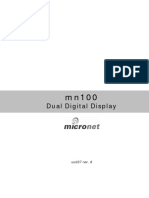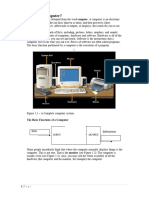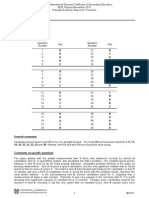Joel A.
Hinay
Systems of Linear Equation
Definition of Terms:
Linear
- straight line; first degree with respect to one or more variables
Equation
- the act or process of equating
- to represent as equal with the use of mathematical symbol
- formal statement of the equality or equivalence of mathematical or logical
expression
Linear Equation
- an equation of the first degree in any number of variables
E.g
1. x + y = 0
3. 3x + 4y = 5
1
2. x + 1 = 2
4. 2 3y + 6x = 0
Linear System
- consist of two or more linear equation
E.g
1. 3x + 4y = 6
2. x + 2y = 0
2x + 6y = 8
6x = 0
3y + 9x = 2
Solution Set
- the set of values that satisfy the equation
Intersecting Lines
- two lines that intersect
Parallel Lines
- two or more lines that do not intersect
Equivalent Equation
- similar or equal equation
Kinds of Linear System
1. Independent System
- A linear system which have exactly one solution set. The graph of an independent
system forms an intersecting line; hence the intersection of the two or more lines
is the solution set.
- Slopes and y-intercept of the two lines are different.
E.g
x + 2y = 6
(1)
x=y
(2)
x + 2y = 6
X
Y
0
3
1
2.5
x=y
2
2
x
y
0
0
1
1
2
2
�2. Inconsistent System
- A system that does not have a solution set. The lines do not share any common
point or pair of values that will satisfy the linear system. It is represented by
parallel lines.
- Slopes of the lines are equal but y-intercepts are different.
E.g
2x + 6y = 12 (1)
2x + 6y = 24 (2)
2x + 6y = 12
0
1
3
2
5
x
y
2
3
4
2x + 6y = 24
0
1
3
4
11
x
y
2
3
10
y
6
0
- 1 4
- 1 2
- 1 0
- 8
- 6
- 4
- 2
1 0
1 2
1 4
- 2
- 4
- 6
3. Dependent System
- A system that has an infinite solution set. Every point lying on line A also lies on
line B. It means, every solution of line A is also a solution of line B.
- Slopes and y-intercept are similar. Thus, Dependent System can be called
Equivalent Equation.
E.g
x + 5y = 5
(1)
9x + 45y= 45 (2)
x + 5y = 5
0
1
x
y
2
4
5
3
3
5
9x + 45y= 45
0
1
4
1
5
x
y
2
3
5
y
3
0
- 7
- 6
- 5
- 4
- 3
- 2
- 1
- 1
- 2
- 3
�Solving Systems of Linear Equation
A. Graphical Method
- The graphs of the linear equations, solution set can be determined provided the
construction of its graphs is accurate. If the graph forms an intersecting line, the
point of intersection is the solution set; on the other hand, if its a parallel line, no
solution set and if the graphs form a straight line, it has infinite solution set.
E.g
x 3y = 0
2x y = 5
Steps:
1. Assign equation 1 and 2
x 3y = 0 (1)
2x y = 5 (2)
2. Assign values of x (at least 2) for both equations
x
y
x 3y = 0 (1)
1
2
x
y
2x y = 5 (2)
1
2
3. Substitute the values of x to the equations to compute the values of y and record
if x = 1; then y =?
x 3y = 0
1 - 3y = 0
1 = 3y
1
y= 3
if x = 3; then y = ?
x 3y =0
3 3y = 0
3 = 3y
if x = 2; then y =?
x 3y = 0
2 - 3y = 0
2 = 3y
2
y= 3
if x = 1; then y = ?
2x y = 5
2(1) y = 5
2y=5
X
Y
y =1
y = -1
y=-3
x 3y = 0 (1)
1
2
1
2
3
3
if x = 2; then y = ?
2x y = 5
2(2) y = 5
4y=5
if x = 3; then y = ?
2x y = 5
2(3) y = 5
6y=5
y=1
3
1
x
y
2x y = 5 (2)
1
2
-3
-1
3
1
4. Plot the ordered pairs of equation 1, and then connect followed by equation 2 in the
coordinate plane
�y
3
0
-7
-6
-5
-4
-3
-2
-1
-1
-2
-3
5. Determine the solution set based from the graphs formed
B. Algebraic Method
B.1. Substitution
- Aims to arrive at an equation in one variable
E.g
x 3y = 0
2x y = 5
Steps:
1. Assign equation 1 and 2
x 3y = 0 (1)
2x y = 5 (2)
2. Choose either equation 1 or 2 to be express in terms of x or y
2x y = 5 (2)
2x = 5 + y
5+ y
x=
express in terms of x
2
3. Substitute the expressed equation to the unexpressed equation
x=
5+ y
2
(express in terms of x)
x 3y = 0 (unexpressed equation)
5+ y
2
- 3y = 0
5+ y
2( 2
5 + y 6y = 0
5 5y = 0
5 = 5y
-3y) = (0)2
y=1
4. Substitute the value computed at step 3 at either equation 1 or 2
Since y = 1; then x =?
x 3y = 0
x 3(1) = 0
x3=0
x=3
Therefore, the solution set is (3,1).
5. Check the solution set by substituting to the equation 1 and 2
x 3y = 0
3 3(1) = 0
33=0
2x y = 5
2(3) 1 = 5
61=5
=0
5=5
*If the value of x and y satisfy both equations, it is the solution set of the equations.
B.2. Elimination
- Aims to eliminate one variable to solve the solution set or the value/s of x and y.
Steps:
1. Assign equation 1 and 2
x 3y = 0 (1)
2x y = 5 (2)
2. Choose a variable to eliminate on both equations
2(x 3y) = (0)2
2x y = 5
2x 6y = 0
- (2x y) = (5)
0 5y = 5
y=1
3. Substitute the value computed at step 2 to either equation 1 or 2
Since y = 1; then x =?
x 3y = 0
x 3(1) = 0
x3=0
x=3
Therefore, the solution set is (3,1).
4. Check the solution set by substitution
x 3y = 0
3 3(1) = 0
33=0
2 =0
2x y = 5
2(3) 1 = 5
61=5
5=5
*If the value of x and y satisfy both equations, it is the solution set of the equations.
Exercises
A. Draw the graphs of the following system of equations. Determine whether they are
independent, inconsistent or dependent system and the solution set.
1. x + y = 6
xy=2
2. x + y = -3
-x + y = 15
3. 2x + y = 10
2x + y = -4
4. 2 x - y = -5
x+y=5
5. x + 2y = 7
x-y=1
6. x + y = 2
2x + 3y = 7
7. x = 2y
x+y=3
8. x + y = 4
2x + 2y = 8
B. Solve the linear equations by a) Graphical Method; b) Elimination and c) Substitution
4. x + y = 10
x - y = -3
5. x + y = 15
6. x + 2y = 12
3. 9x + 3y = 21
2x - 3y = 1
4. x + 2y = 4
x - y = 10
5. 2x + 3y = 10
2x 2y = -15
�Reference:
Anderson, Johnston. Algebra. The Mathematical Curriculum. Glasgow: Blackie, 1978.
Hart, K.M. ed. Childrens Understanding of Mathematics: 11-16. London: John Murray, 1981.
Jacobs, Harold. Geometry. San Francisco; W.H. Freeman and Company, 1974


